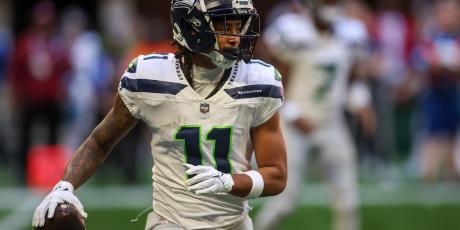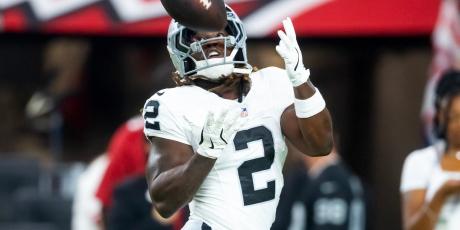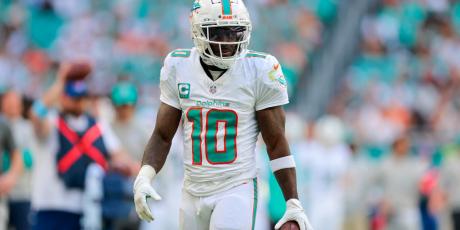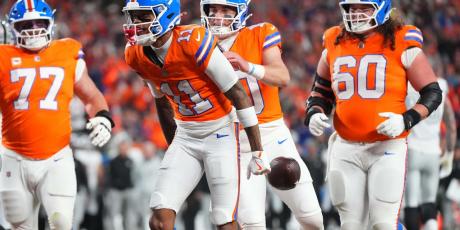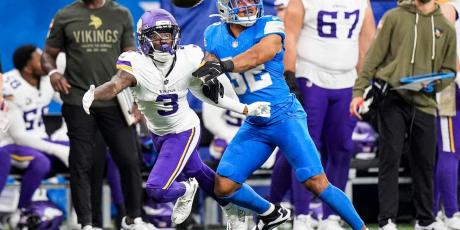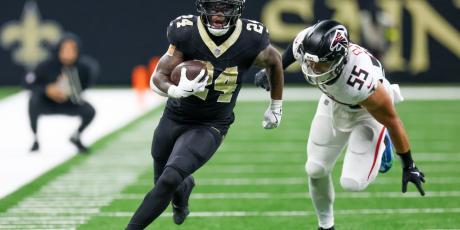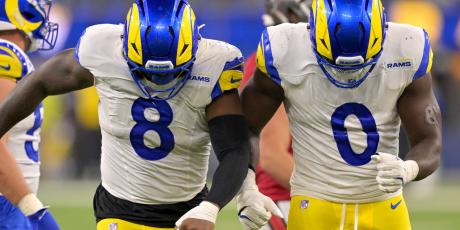Rashod Bateman Won’t Impact the Ravens in 2021

Fun fact: there’s only one NFL team nicknamed after a poem. Less fun fact: there’s also only one team still playing like it’s 1845, the year Edgar Allen Poe penned the seminal piece of literature that inspired their mascot.
The Baltimore Ravens, literary references aside, are no fantasy football fan’s favorite franchise for pairing with prominent pass-catching prospects. This reticence to trust Baltimore receivers has good reason. With dual-threat quarterback Lamar Jackson under center, the Ravens have been one of the most run-heavy teams in the league.
2021 first-round rookie wide receiver Rashod Bateman’s arrival may further clutter this target distribution and make you wish to “nevermore” draft a wideout from the team. Will his presence instill fear in incumbent top receiver Marquise Brown? Or might his rapping on the coaches’ door get the offense passing more?
Usage and Roles on the Field
To comprehend Bateman’s fit on your fantasy roster, it’s helpful to understand his fit on the Ravens’ depth chart. Baltimore has been searching for a true “number-one” wide receiver for years now.
This doesn’t just mean the wideout who sees the most targets on a team. A real “X” receiver (or split end) is a physical receiver who lines up on the line, can consistently beat press-man coverage and is expected to soak up a lot of targets.
Rashod Bateman—who looks bigger on tape than the 6-foot-0,190-pounds he weighed in at—feels like that kind of guy on the surface. Bateman runs a 4.43 forty-yard dash (a 77th percentile mark), boasts 33-inch arms (78th percentile), and has the requisite agility (6.95 three-cone; 50th percentile) to theoretically evade the jam through either power or finesse.
Despite spending 60.7% of his time in the slot in 2020 (PFF), Bateman doesn’t seem to have any qualms with press-man coverage. The table below shows his production rates against both man and zone coverages in 2020.
| Coverage | Targets | Catch % | Yards per Rec | TD % | Targeted QB Rating |
|---|---|---|---|---|---|
| Man | 23 | 69.6 | 13.6 | 4.3% | 95.9 |
|
Zone
|
28 | 60.7 | 14.4 | 0.0% | 59.2 |
Bateman was able to double his quarterback’s passer rating when targeted in a one-on-one situation. That’s difficult to do; the average wide receiver to see 45 or more targets in the NCAA this year had a targeted QB rating nearly five points lower against man than zone. Bateman’s college production helps confirm his tools: he should be able to handle the Ravens’ split end position.
His starting counterpart, Marquise Brown, is a more diminutive 5-foot-9 and 180 pounds. Brown makes up for that small stature with immense speed, though, having run a blazing 4.27 forty-yard dash at his Pro Day in 2019. Still, Brown is more than just a ball of energy. His skill set has proven talented enough to work from the “Z” role (or flanker):

He can line up and battle in the slot:
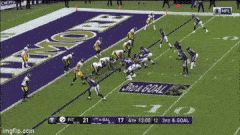
And he can also handle the “X”:

Brown rarely plays in the slot despite his smaller size and electric quickness. He has spent just 22.7% of his snaps there in the NFL (23% in college), as offensive coordinator Greg Roman has utilized his versatile skill set all over the field. Thanks to this, Brown has played more snaps and been more fantasy-efficient with them than any Ravens receiver since he entered the league, generating 0.24 PPR per snap. He did have a slight dip in efficiency this year, possibly partly due to struggling with an increase in downfield work (seventh-highest market share of air yards) as he learned a new role in a pandemic-disrupted offseason program.
| Depth | 2019 Target % | 2020 Target % | 2019 Yards per Target | 2020 Yards per Target | 2019 Catch % | 2020 Catch % |
|---|---|---|---|---|---|---|
| Medium & Deep Targets | 40.0% | 49.5% | 13.1 | 11.4 | 46.2% | 44.7% |
| Short & Behind LOS Targets | 60.0% | 50.5% | 6.3 | 4.9 | 87.2% | 77.1% |
With all this in mind, Bateman seems poised to step into a large target share as the probable “X” receiver, though Brown’s versatility in position and role may allow Baltimore to manufacture touches for him as more than a traditional “Z”.
How will the workload break down among these two?
Target Shares and Team Passing
There’s a common belief that wide receivers tend to take two years to develop, and “break out” in Year 3. If true, it seems wrong to expect Rashod Bateman to do much in his rookie season.
To test this idea, I compiled target market share data for the 78 first-round wide receivers drafted since 2001, including their production, their team’s production, and the production of the team’s top three wide receivers—both in the first rounder’s rookie season and the year before.
What impact does a first-round rookie receiver have on a team's target distribution? Will they steal value from the lower-end starters, or does their high draft capital signal a step into an immediate top role? The table below shows their impact on the depth chart.
| Depth Chart Position | Year Before | Rookie Year | Difference |
|---|---|---|---|
| Round 1 Rookie WR | – | 11.7% | – |
| WR1 | 22.0% | 22.6% | +0.6% |
| WR2 | 14.9% | 15.0% | +0.1% |
| WR3 | 9.6% | 10.1% | +0.5% |
In actuality, there is a slight average increase for the target market share of every wide receiver on the depth chart from the previous season. Rather than stealing work from his position-mates, a first-round rookie receiver seems to take defensive pressure off of them.
You’ll also notice that the “Round 1 Rookie WR” has a similar target share to the “WR3”; many of the first-round rookies ended up as the third-most targeted wideout on their team in their first season. Therefore, the increase in target share for the WR3 spot was almost certainly due to the addition of better talent.
The same effect is true of basically any market share we look at here. Receiving yards? Rookie first-rounders typically earn about 14%, while the average WR1 and WR2 increase their receiving yards share by a percentage point or so. Touchdown share? High-end rookies typically see 14%, and there’s no meaningful difference for WR1’s or WR2’s. Even yards per target, looking at how roles might be impacted, shows little change from the year before a wide receiver is drafted in the first round to the year after.
The other final element to examine here is if the addition of another top-tier receiving talent would encourage the Ravens to #LetLamarCook and open up the passing game.
In short: nope.
| Stat Categories | Year Before | Year After | Difference |
|---|---|---|---|
| Pass Attempts | 534.5 | 545.5 | +2.1% |
| Completion % | 60.4% | 60.8% | +0.4% |
| Pass Yds per Att | 6.4 | 6.4 | +0.0% |
| TD % | 4.2% | 4.0% | -0.2% |
| INT % | 2.8% | 2.8% | +0.0% |
| Passer Rating | 83.3 | 82.7 | -0.8% |
As you can see, teams have only passed about 2% more the year after drafting a receiver in the first. The efficiency of the passing game—yards per attempt, touchdown rate, interception rate, etc.—didn’t really change in a meaningful way either.
Takeaways
- Rashod Bateman has the tools to succeed on the Ravens, but a murky depth chart and low volume passing game will likely hinder his rookie production. Bateman’s ADP by Underdog Fantasy puts him as a fantasy WR5, somewhere in the early 11th round of drafts.
- Average first-round rookie receivers produced 102.4 PPR (a high-end WR7 in 2020), but their average 11.7% target market share in Baltimore’s low volume pass offense suggests he could earn closer to 63.0 PPR (a low-end WR9). Drafting Bateman as a fantasy WR5 is hoping for a massive passing volume increase that isn’t likely to happen.
- Marquise Brown is still in a good position to lead the team in targets and air yards in 2021, which sets him up to be a strong best ball player.
- Brown is being drafted in the early eighth round as a fantasy WR4 but flashes WR1 upside (16.0 PPR per game over the last six weeks of 2020). He’s well worth taking in the sixth or seventh round to secure his upside--still a four-round discount from his ADP in summer 2020. The sour taste of his poor 2020 season-long total and the rookie allure of Bateman should keep Brown's ADP lower than comparable wideouts.
- We should expect the Lamar Jackson-based, run-heavy offense to continue. Despite offensive coordinator Greg Roman's recent comments, Baltimore will still probably attempt fewer than 500 passes in 2021, keeping the pass-catchers' fantasy ceilings low.


